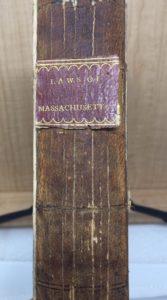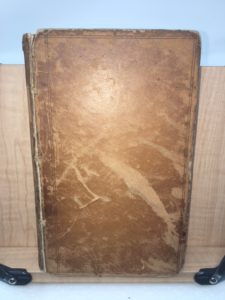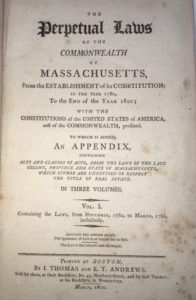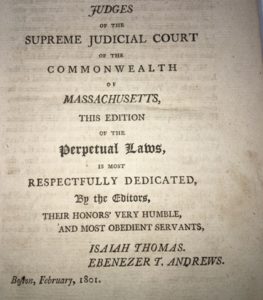The Perpetual Laws of the Commonwealth of Massachusetts, from the Establishment of its Constitution to the First Session of the General Court in 1788, compiled by Isaiah Thomas, printed in Worcester, Mass.
Isaiah Thomas’ Perpetual Laws of the Commonwealth of Massachusetts was the first collection of Massachusetts statutes up to 1788, the year of ratification of the U.S. Constitution. The Perpetual Laws includes the Massachusetts Constitution, the world’s oldest functioning constitution. It was purposely printed in a smaller size and at a lower price to facilitate wide scale distribution. Click here for a link to the 1788, first edition of the Perpetual Laws.
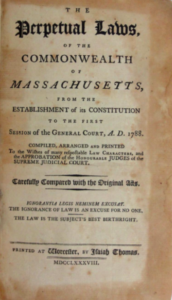 A second edition of the Perpetual Laws was published in 1801, covering the period of 1780 – 1800, including the Constitutions of the United States and the Commonwealth of Massachusetts. The 1801 edition was printed by Thomas and E. T. Andrews in Boston and sold directly through Thomas’ growing chain of bookstores. Click here for a discussion of the role of the Massachusetts Constitution as a template for the U.S. Constitution.
A second edition of the Perpetual Laws was published in 1801, covering the period of 1780 – 1800, including the Constitutions of the United States and the Commonwealth of Massachusetts. The 1801 edition was printed by Thomas and E. T. Andrews in Boston and sold directly through Thomas’ growing chain of bookstores. Click here for a discussion of the role of the Massachusetts Constitution as a template for the U.S. Constitution.
As described by Thomas in the preface, Massachusetts statutes had never been printed in a “well digested order.” As a result, “general complaint has been made for the want of such a work.” Thomas further explained his intention was “to make the book convenient for the pocket, and cheap to the purchaser that the laws might be more generally diffeminated throughout the Commonwealth.”
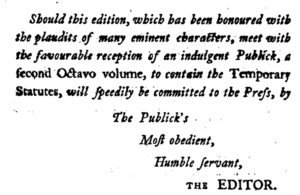 Thomas signed the preface as “the Publick’s Moft Obedient, Humble fervant, THE EDITOR.” This salutation will sound familiar to fans of Lin-Manuel Miranda’s Broadway production of Hamilton.
Thomas signed the preface as “the Publick’s Moft Obedient, Humble fervant, THE EDITOR.” This salutation will sound familiar to fans of Lin-Manuel Miranda’s Broadway production of Hamilton.
The title page contains the Latin quote that “Ignorantia Legis Neminem Excus At,” meaning that “Ignorance of Law is an Excuse for No One.” The title page also indicates that “The law is the Subject’s Best Birthright.”
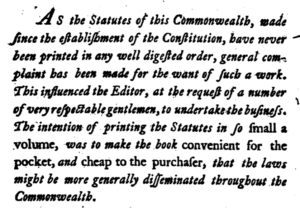 The accuracy of the statutory compilation was certified by Commonwealth Secretary John Avery, who signified that he carefully compared the work with the original statutes. Thomas explains that he purposely omitted local and private acts which are not of general utility, “which if inferted would have greatly fwelled the volume and enhanced its price.”
The accuracy of the statutory compilation was certified by Commonwealth Secretary John Avery, who signified that he carefully compared the work with the original statutes. Thomas explains that he purposely omitted local and private acts which are not of general utility, “which if inferted would have greatly fwelled the volume and enhanced its price.”
Unlike the first volume, the second edition was specifically ordered by the “General Court.”
Click here for more information about patriot publisher Isaiah Thomas.
Background about the “General Court of Massachusetts”: For those outside of Massachusetts, it is worth noting that the Massachusetts State Legislature is officially known as the “General Court of Massachusetts.” This name is a historic artifact arising from the early days of the Massachusetts Bay Colony when the colonial assembly sat as an appellate court. Prior to the adoption of the Massachusetts constitution of 1780, the body was known as the “Great and General Court.” Its name was shortened by John Adams when he almost single handedly wrote the Massachusetts constitution of 1780.
Curiously, the only other state that calls its legislative body a “General Court” is New Hampshire. Approximately 20 states refer to their legislature as a “General Assembly.” As with most states the Massachusetts General Court is a bicameral body consisting of a Senate and House of Representatives. Today the Massachusetts Senate is composed of 40 members and sits as the upper house. The lower House of Representatives has 160 members. In 1978, the number of Representatives was reduced to its current size from 240 members.
Ratification of the U.S. Constitution: The Constitution required ratification by 9 of the 13 colonies. This was a controversial departure from the Articles of Confederation which required unanimity. Nevertheless, on June 21, 1788, New Hampshire became the ninth state to ratify the U.S. Constitution. It was subsequently decided that the first Congress would convene on March 4, 1789.
Virginia ratified the Constitution in June of 1788. New York followed in July of 1788. North Carolina became the 12th state when it ratified the constitution in November 1789, immediately following the adoption of the Bill of Rights by Congress on September 25, 1789. Famously, Rhode Island was the last to ratify on May 29, 1790, after the federal government threatened to sever commercial relations. Ten of the twelve amendments constituting the Bill of Rights were ratified in 1791.
Click here for a link to the 1788, first edition of the Perpetual Laws
Click here for a link to Volume II of the 1801 edition of the Perpetual Laws
Other legal publications by Thomas include:
An early American edition of Blackstone’s Commentaries on the Laws of England (Isaiah Thomas: Worcester, 1790) (the first edition of Blackstone’s Commentaries published in Massachusetts)
Montesquieu’s The Spirit of Laws. (Worcester: Isaiah Thomas, Jr., 1802.) (first American edition, taken from the fifth London edition)
Freeman, Samuel, The Massachusetts justice: being a collection of the laws of the Commonwealth of Massachusetts, relative to the power and duty of justices of the peace. (Boston: Isaiah Thomas and Ebenezer Andrews, 1795)
Plutarch’s Lives, translated from the original Greek by John and William Langhorne (Worcester 1804)
